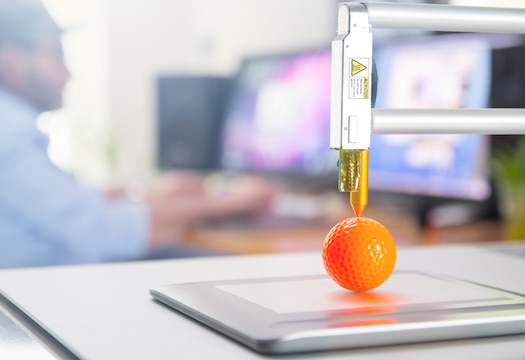“Ménière noted that ‘the rise of [3D printing technologies] has recently helped to keep health services functioning thanks to the printing of valves for ventilators that can keep the people hardest hit by COVID-19 alive.’”
 On July 13, the European Patent Office (EPO) published a landscaping study titled “Patents and additive manufacturing: Trends in 3D printing technologies”. The study highlighted current trends and identified industry leaders in additive manufacturing (AM), i.e. 3D printing. It noted that between 2015 and 2018 the number of AM patent applications increased at an average annual rate of 36%, with more than 4,000 AM patent applications filed in 2018 alone.
On July 13, the European Patent Office (EPO) published a landscaping study titled “Patents and additive manufacturing: Trends in 3D printing technologies”. The study highlighted current trends and identified industry leaders in additive manufacturing (AM), i.e. 3D printing. It noted that between 2015 and 2018 the number of AM patent applications increased at an average annual rate of 36%, with more than 4,000 AM patent applications filed in 2018 alone.
AM technology is used in a wide variety of industries, including medical and health, energy and transportation, industrial tooling, electronics, construction, consumer goods, and the food sector. A ranking of the top applicants for AM patents revealed that U.S. companies lead, with 11 companies in the top 25 applicants, followed by Europe with eight companies in the top 25. The purpose of the study was to “inform users of the patent system and the broader public about a technology trend that is set to transform a wide range of industry sectors.”
Yann Ménière, Chief Economist of the EPO, said that these patent applications herald a new age in AM:
The patent applications that we have received in recent years lay the groundwork for the expansion of additive manufacturing for new uses in more sectors. As the technology matures, it has the potential to redesign entire industry value chains, further impacting the price of goods, consumer experiences and labour market conditions. The rise of AM will oblige companies to rethink their distribution models and adapt to new forms of competition, while facing the challenge of creating appropriate legal frameworks to safeguard their products.
Current Trends and Expected Development of AM
The study noted that AM patenting activity has been steadily increasing since the year 2000; between 2014 and 2018 the number of applications increased by 239%, from 1,200 applications filed in 2014 to more than 4,000 applications in 2018. Currently, AM is predominantly used for prototyping, but is also used for production of finished goods, the production of tooling, and for research and educational purposes across many technical fields, including healthcare, automotive, and aerospace. The study noted that, although AM technology is becoming more common and familiar in some areas, there is still a strong potential for further growth. However, there are still a number of challenges that hinder the deployment of AM, such as the cost of raw materials for printing and the cost of post-processing requirements such as smoothing, sanding or assembling. Further, printing speed can be slow and restrictive, but the study pointed out that “[a]dvances in design engineering, software, material science and [standardization]/certification (e.g. in the specifications in the design file, such as process parameters and material composition) will reduce these limitations over time.”

Yann Ménière, Chief Economist, EPO
Major discernable trends in AM include materials diversification, design progress, mass customization and collaboration and consolidation. The study explained that new materials are quickly being introduced and the number of materials suppliers is increasing, thereby reducing costs and improving the properties and quality of the materials. Research is also being conducted to broaden the scope of available materials, particularly in composite and hybrid materials. The study also noted that ISO standards are being developed for AM design, which indicates a consensus within the AM industry. Further, the study predicted that AM companies will rely on each other to provide the required services such as design, simulation, parts building and testing. Thus, the study explained that “it is expected that innovation will be driven by a growing number of partnerships and collaborations, followed by consolidation in the market.” In commenting on trends in AM over the last several months, Ménière noted that “the rise of AM has recently helped to keep health services functioning thanks to the printing of valves for ventilators that can keep the people hardest hit by COVID-19 alive. It is also set to have a profound economic impact on supply chains and business models in various sectors in the years to come.”
AM Technology Sectors and Domains
The study broke AM technology down into four technology sectors: Materials, Machines and processes, Digital and Application domains. The Materials sector included both core materials and assisting materials and the Machines and processes sector referred to printers and other peripheral devices used for AM techniques. The Digital sector referred to the digital design of the product to be manufactured and control of the equipment and processes for carrying out AM techniques. Further, the Application domains sector was described as “a transversal category covering the applications of AM technologies in different industries” and was broken down into eight separate application domains: Transportation, Industrial tooling, Health, Food, Energy, Electronics, Consumer goods and Construction.
Of the four technology sectors, the study revealed that Application domains had the largest share of EPO patent applications with a share of 50%, followed by Machines and processes with a share of 38%. The smallest share was for the Digital sector with a share of 11%. The Application domains sector also had the highest increase in AM patent applications between 2014 and 2018, with the number of AM applications tripling over that time period. The Machines and Processes sector has also seen a large increase in recent years with the number of AM applications increasing by more than 300% between 2014 and 2018. The study also illustrated that the top developments in the Application domains sector were in Health, which included 3D products for medical implants, prosthetics, surgery tools, pharmacological preparations and educational models. The Energy domain of the Application domains sector, which includes heat exchangers, turbine engines, batteries and magnets, had the second greatest amount of growth, with more than 2,000 AM applications being filed between 2014 and 2018. The third largest domain was Transportation, followed by Industrial tooling, Electronics, Construction, Consumer goods and Food.
Top Applicants of AM Inventions
The study also set forth the top 25 AM patent applicants at the EPO between the years 2000-2018 and their role in the different AM technology sectors. The top 25 AM patent applicants made up 30% of all AM patent applications filed and included large companies from a variety of sectors including “transportation, chemicals and pharmaceuticals, information technology, electronics, imaging and consumer goods, as well as AM specialists such as Stratasys and 3D Systems.” The U.S. Companies General Electric and United Technologies were the clear leaders with over 800 patent applications each, followed by the German company Siemens with 645 applications.
The top 25 AM patent applicants were analyzed by their activity in the four AM technology sectors, revealing that some companies are active in several sectors while others are active in only one. General Electric was the only company in the top 25 patent applicants that was in the top five of every technology sector, with General Electric’s greatest contribution being in the Machines and processes sector, followed by the Application domains sector. United technologies made the greatest contribution to the Application domains sector and Siemens’s greatest contribution was in Machines and processes. For most of the AM technology sectors and domains, the industry sector of the companies determined the largest contributors. For example, Consumer goods was led by the sporting goods manufactures Nike and Adidas and Health was led by medical equipment manufacturers such as Johnson & Johnson. Overall, computer and electronics manufacturers and transport equipment manufacturers contribute the largest shares of AM patent applications filed by companies with shares of 21.1% and 20.1%, respectively. The chemical industry sector comes in third with a contribution of 14.7% of AM patent applications filed by companies. The study also revealed that two-thirds of AM patent applications were filed by large companies having more than 1,000 employees. However, smaller companies and individual inventors contributed significantly to AM inventive activity, with a combined contribution of 22%.
Geographical Origins of AM Applications
According to the study, the U.S. and Europe combined accounted for four out of five AM patent applications filed in the EPO between the years 2000 and 2018. Europe (all of the EPC contracting states combined), came first with a contribution of 45.6% of AM applications and the U.S. came in second with a contribution of 34.7%. Japan came in third, with a contribution of 11.8%, and applications from the rest of the world totaled about 7%. Of the EPC contracting states, the largest contribution was made by German inventors, i.e. 19%. The United Kingdom, France, the Netherlands and Switzerland each contributed about 4-5% and the remaining 10% of Europe’s contribution is spread across 28 other European countries.
“We are only seeing the beginning of innovation in additive manufacturing, and our data show that there’s much more to come, in particular in the sector of consumer goods, but also in sectors such as biology or electronics,” added Ménière. “There’s plenty of space to innovate. Our landscaping study demonstrates that this is not a field of giants, but that there is a huge diversity of patent applications and actors.”

![[IPWatchdog Logo]](https://ipwatchdog.com/wp-content/themes/IPWatchdog%20-%202023/assets/images/temp/logo-small@2x.png)

![[[Advertisement]]](https://ipwatchdog.com/wp-content/uploads/2024/04/Patent-Litigation-Masters-2024-banner-early-bird-ends-Apr-21-last-chance-938x313-1.jpeg)
![[Advertisement]](https://ipwatchdog.com/wp-content/uploads/2024/04/Patent-Litigation-Masters-2024-sidebar-early-bird-ends-Apr-21-last-chance-700x500-1.jpg)

![[Advertisement]](https://ipwatchdog.com/wp-content/uploads/2021/12/WEBINAR-336-x-280-px.png)
![[Advertisement]](https://ipwatchdog.com/wp-content/uploads/2021/12/2021-Patent-Practice-on-Demand-recorded-Feb-2021-336-x-280.jpg)
![[Advertisement]](https://ipwatchdog.com/wp-content/uploads/2021/12/Ad-4-The-Invent-Patent-System™.png)







Join the Discussion
One comment so far.
David Stein
July 19, 2020 12:57 pmIt’s been great experiencing additive manufacturing at the consumer level. It reminds me of consumer printers, when 1980s devices (pen-based plotters and tractor-feed printers, using the folded paper with feed strips on the sides) steadily developed into consumer inkjets and laserjets with steadily improving quality and reliability. Consumer 3D printers are on the same track: my first device (a FlashForge 3D printer) required more time on repairs and maintenance, and my second device (a Prusa i3 MK3) is a major leap forward in several areas.
It’s also been fascinating following additive manufacturing in industry, as the technology is reaching the point where even some instances of mass-produced products have some competitive advantages to traditional techniques like injection molding. Several startups are based on in-house mass 3D printing, particularly where runs are limited, customization is substantial, and turnaround time from design to delivery is short.
As the EPO report indicates, the patent landscape for additive manufacturing is robust – we can expect a long pipeline of improvements for decades to come.